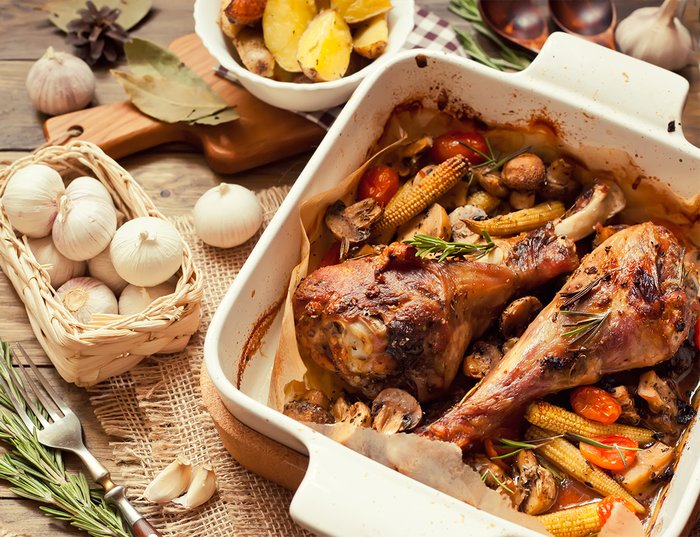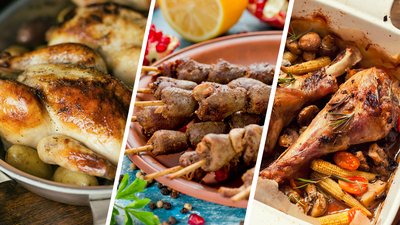Just like there are perfectly good substitutes for good ol' broccoli (Brussels sprouts, cauliflower, broccoli rabe), there are more poultry-protein choices available these days than good ol' chicken breast. To be sure, there's nothing wrong with chicken and broccoli, but, hey, variety is the spice of life. And the more interesting your meals are, the greater your chances of sticking with your meal plan.
Different kinds of poultry can add new and improved flavors to your meal. They can also provide a greater diversity of must-have nutrients. Local markets offer so many poultry options these days that there's no reason to limit yourself to endless line of chicken breasts.
1. Cornish Game Hen
Even though they're called "game" hens, these birds are simply a breed of commercially raised chicken. Entering the processing plant at a mere 2-1/2 pounds or less, each table-ready Cornish hen provides about 50 grams of protein, mostly in the form of white meat.
These hens also supply niacin, a B vitamin that numerous enzymes in your body must have for proper energy metabolism. The hens provide selenium, too, which is good news for men. A study in the British Journal of Nutrition reported that men with higher levels of blood selenium were at lower risk of prostate cancer.[1]

Because whole Cornish game hens are so much smaller than mature chickens or turkeys, they are much easier to roast. Simply tie the legs together with kitchen twine, tuck wing tips underneath, and place one or more hens in a large baking dish, breast side up. Brush the bird or birds with some olive oil and season with salt and black pepper and seasonings of choice. Roast the hens at 400 degrees F for about 55 minutes, or until the breast registers 165 degrees F. Let the bird rest 15 minutes before slicing. You can also use the cooked meat in sandwiches, soups, and salads.
If you want to trim some calories from your meal while still locking in flavor, roast the hen with the skin on, then peel off the skin and throw it away. You can find fresh or frozen Cornish hen alongside other poultry in some supermarkets and often at well-stocked butchers.
2. Turkey Drumsticks
Thanksgiving doesn't need to be the only time you grab hold of this economical delicious cut of turkey. Since turkeys use their legs continuously, their drumsticks contain more myoglobin, a type of protein that ships oxygen to muscle cells to generate energy.
Neither domestic turkeys nor chickens use their chest muscles much, so you don't get a lot of myoglobin from their breast meat. They do run around a lot, though, so all that extra activity contributes to the drumstick's richer, more succulent flavor—and its reddish color: Myoglobin is chiefly responsible for the meat's pink-to-red hue.

For some reason, dark poultry meat has a bad nutritional rap compared to white meat. Yes, dark meat does contain a few more calories and a little extra fat. But the fact is that nearly anyone can spare the extra 30 calories and 1 gram of saturated fat in a 3-ounce serving of dark meat, especially when this meat has such a superior nutrition profile.
Compared to white meat, dark poultry meat like turkey drumsticks gives you the same amount of protein, about 17 grams per 3-ounce serving. It also provides more B vitamins, iron, and zinc, which your body needs to generate cells that help you resist disease.
To prepare, season the drumsticks to your taste, then roast them in the oven at 350 degree F until the internal temperature of the leg reaches 175 degrees F. As with Cornish game hens, you can roast the drumsticks with the skin still on, then peel it off afterward to avoid extra saturated-fat calories.
You can also slowly simmer (braise) the drumsticks in seasoned broth on the stovetop or in a slow cooker. This method creates meat that's fall-off-the-bone tender.
3. Chicken Hearts
Chicken hearts might not be the first thing you think of when you're looking for poultry protein, but these little morsels are worth a try. First of all, they're more deeply flavored than more popular cuts of chicken and have a strangely pleasant chew.
As with most other organ meats, chicken hearts are a great way to rack up the protein and other important nutrients like zinc, iron, and vitamin B-12. In general, organ meats tend to be more nutrient-dense than standard supermarket cuts. And it's not just your body, but your bank account, that will thank you: Chicken hearts cost about a third of what you'll shell out for breast meat.

An easy way to prepare chicken hearts is to simply marinate them in some oil and seasonings like garlic and chili for a few hours, then sauté or stir-fry them with some vegetables. Any Asian-style stir-fry recipe calling for chicken will work great for this cut. You can also skewer chicken hearts and grill them kebab style.
Since chicken hearts are small, impatient cooks will appreciate that they cook in only about 5 minutes in a hot pan or on a grill grate. Can't find them at your local supermarket? Try butchers that offer poultry or at many Hispanic markets.
Some people shy away from chicken hearts because they—the people, I mean—are, well…chicken. But making this food choice helps sustain a more sustainable meat supply in which we eat all of the parts of the animals we slaughter.
References
- Outzen, M., Tjønneland, A., Larsen, E. H., Friis, S., Larsen, S. B., Christensen, J., ... & Olsen, A. (2016). Selenium status and risk of prostate cancer in a Danish population. British Journal of Nutrition, 115(9), 1669-1677.

